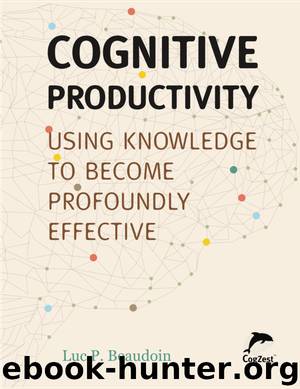Cognitive Productivity by Luc P. Beaudoin

Author:Luc P. Beaudoin [Luc P. Beaudoin]
Language: eng
Format: epub
Publisher: leanpub.com
Published: 2013-06-09T00:00:00+00:00
11.3.3 Assessing explanatory theories
“Have the courage to use your own understanding,” is therefore the motto of the enlightenment.
Immanuel Kant
We are often faced with alternative explanations for the same phenomena (known possibilities). How might one assess their respective strengths and weaknesses? To answer this in a general way, one could select sets of explanatory theories that deal with related phenomena. For example, for each of the following one could identify rival explanations and contrast them: the sketch of mind presented in chapter 5, Gottman’s explanation of what makes marriages fail, Ries’s explanation of why startups thrive or fail, an explanation of why Skype keeps dropping calls. Consider them or other explanatory theories recently as you contrast your answer to this question with the answer provided below. We, knowledge workers, sometimes fool ourselves into believing that in the final analysis, a theory’s ability to quantitatively predict phenomena is what matters. Here are some criteria we use to select between theories or to criticize and improve them, most of which are adapted from Sloman (1978).
Is the theory sufficiently definite? Ideally, it is clear what counts as a phenomenon to be explained by the theory vs. what it does not cover. The broad theory of the mind sketched in chapter 5 is meant to account for purposive behavior but is not meant to specify fine details of execution (e.g., how speech is produced, how visual perception happens).
How general is the theory? The more general the better. Thayer’s (2001) two-dimensional theory of moods accounts for all kinds of mood states in a compelling way. A theory that could also account for all kinds of other affective states and processes, such as perturbances, attitudes and motive processing would be preferable all other things being equal.
Is the theory sufficiently parsimonious? How could it be altered to make it simpler and better? This criterion is can be taken too far. “I think that when we are speculating about very complicated adaptive systems, such as the human brain and social systems, we should especially beware of oversimplification—I call such oversimplification ‘Ockham’s lobotomy’.” (Good, 1971 p. 375).
Is it mechanistic and mechanistically plausible? Many theories fall short of being good explanations because they do not reveal the hidden mechanisms that make the observed phenomena plausible. Yet the essence of an explanation of possibilities is to shed light on internal mechanisms, which must be plausible once understood. Ideally, one could construct a computer simulation of the theory to reproduce or simulate the observed behavior. Behaviorists fail to explain motivated behavior in this way—they abstemiously avoid speculating about underlying mechanisms and stick to observable input/output constructs.
Does the theory account for fine-grained structure? Freud’s psychoanalytic theory provided coarse mechanisms for some motivated behavior, but failed to address how people could even in ordinary circumstances generate goals, plan for them, schedule them and pursue them. AI researchers in contrast have tried to explain mentation in fine detail. Thayer’s two-dimensional theory of moods is general and has heuristic power; but it does not account for the fine-structure of the cognitive content of affective states.
Download
This site does not store any files on its server. We only index and link to content provided by other sites. Please contact the content providers to delete copyright contents if any and email us, we'll remove relevant links or contents immediately.
| Administration & Medicine Economics | Allied Health Professions |
| Basic Sciences | Dentistry |
| History | Medical Informatics |
| Medicine | Nursing |
| Pharmacology | Psychology |
| Research | Veterinary Medicine |
The Art of Thinking Clearly by Rolf Dobelli(10126)
The 5 Love Languages: The Secret to Love That Lasts by Gary Chapman(9497)
Mindhunter: Inside the FBI's Elite Serial Crime Unit by John E. Douglas & Mark Olshaker(9094)
Becoming Supernatural by Dr. Joe Dispenza(8029)
The Road Less Traveled by M. Scott Peck(7466)
Nudge - Improving Decisions about Health, Wealth, and Happiness by Thaler Sunstein(7451)
Mastermind: How to Think Like Sherlock Holmes by Maria Konnikova(7149)
Enlightenment Now: The Case for Reason, Science, Humanism, and Progress by Steven Pinker(7078)
Win Bigly by Scott Adams(7027)
The Way of Zen by Alan W. Watts(6444)
Factfulness: Ten Reasons We're Wrong About the World – and Why Things Are Better Than You Think by Hans Rosling(4618)
The State of Affairs by Esther Perel(4583)
Gerald's Game by Stephen King(4508)
Man's Search for Meaning by Viktor Frankl(4344)
The Confidence Code by Katty Kay(4151)
Thinking in Bets by Annie Duke(4113)
Hidden Persuasion: 33 psychological influence techniques in advertising by Marc Andrews & Matthijs van Leeuwen & Rick van Baaren(3411)
The Worm at the Core by Sheldon Solomon(3391)
The Healing Self by Deepak Chopra(3390)
